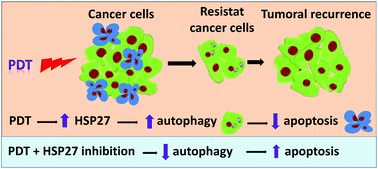Heat shock protein 27 modulates autophagy and promotes cell survival after photodynamic therapy
Abstract
Photodynamic therapy (PDT) is a clinically approved treatment that exerts a selective cytotoxic activity toward cancer cells. The procedure involves the administration of a photosensitizer drug followed by its activation by visible light. In the presence of oxygen, a series of events lead to tumor cell death. PDT releases different cell signals, some of these lead to death while others can lead to survival. The surviving or resistant cells contribute to the recurrence of tumors after treatment, from which the necessity to understand this molecular response induced by PDT arises. It has been shown that both Heat Shock Proteins (HSPs) and autophagy promote PDT resistance. Moreover, both of them can be stimulated by PDT treatment. However, the molecular interplay between HSPs and autophagy in the photodynamic therapy context is poorly understood. We studied whether PDT induces autophagic activity through HSPs. We demonstrated that PDT promoted HSP27 expression, which in turn triggered autophagic cell survival as well as inhibited apoptosis in colon cancer cells. In addition, an overexpression of the HSP27/autophagy axis was observed in skin carcinoma cells resistant to PDT.



 Please wait while we load your content...
Please wait while we load your content...